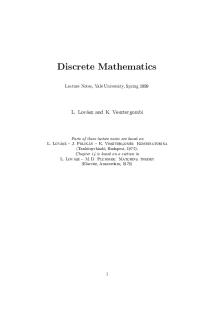Discrete Mathematics - Lecture 1.4 Predicates and Quantifiers PDF

| Title | Discrete Mathematics - Lecture 1.4 Predicates and Quantifiers |
|---|---|
| Course | Discrete Mathematics |
| Institution | University of Houston |
| Pages | 5 |
| File Size | 541.6 KB |
| File Type | |
| Total Downloads | 55 |
| Total Views | 134 |
Summary
Discrete Mathematics - Lecture 1.4 Predicates and Quantifiers...
Description
Math 3336 Section 1.4 Predicates and Quantifiers Predicates Propositional logic is not enough to express the meaning of all statements in mathematics and natural language. Examples: Is “ 1” True or False?
Is “
i
” True or False?
Predicate Logic • Variables: , , , etc. • Predicates: (), (), etc. • Quantifiers: Universal and Existential • Connectives from propositional logic carry over to predicate logic. A predicate () is a declarative se () is also said to be the value of t () becomes a
n when
Examples (Propositional Functions): 1. Let () be “ a.
2.
1.” Determine the truth value of
)
Let (, , ) be “
b. (−2) →
.” Find these truth values:
a. (2, −1, 5)
b.
Page 1 of 5
, 3,
We need quantifiers to express the meaning of English words including • •
and s
“All students in this class are computer science majors” “There is a math major student in this class”
The two most important quantifiers are: l,” symbol e exists,” sy
• •
We wr ). • ∀ () asserts () is true for If = {1 , 2 , … , } , then •
in the
∀ () = (1 ) ∧ (2 ) … ∧ ( ).
∃ () asserts () is true for If = {1 , 2 , … , } , then
.
in the
.
∃ () = (1 ) ∨ (2 ) … ∨ ( ).
Examples: 1. Let (): “ ” with the domain of ). Find the truth value of
.
2. Let (): “ ” with the domain of Find the truth value of
•
.
The truth value of ∃ () and ∀ () depends () and on the .
on the
Quantifiers Statement ∀ () ∃ ()
When True? () is true for There is
When False? .
which () is .
Page 2 of 5
There is ( () is f
Example: Suppose the domain of the propositional function (): consists of . Write out each of the following propositions using conjunction or disjunction and determine its truth value. 1. ∀ () 2. ∃ ()
An element for which () is false is called a Precedence of Quantifiers The quantifiers
and
have
than
Example: ∀ () ∨ () means (∀ ()) ∨ (). ∀ (() ∨ ()) means something different. Negating Quantifiers De Morgan laws for quantifiers (the rules for negating quantifiers) are:
Example: Write the negations of the statements: 1.
an honest politician.”
3. ∀( 2 > )
Page 3 of 5
Translating from English into Logical Expressions Examples: Translate the statements into the logical symbols. Let . 1. in your class can speak Hindi. 2. in your class is friendly. 3. a student in your class who was not born in California. () = “ ”, () = “ , ” ( ) = “
Example: Translate the following sentence into predicate logic and give its negation: “Every student in this class has taken a course in Java.” Solution: First, decide on the domain U! Solution 1: If U is “ Solution 2: But if
define a propositional function ” and translate as , also define a propositional function ” and translate as
Page 4 of 5
) denoting
) denoting “
Example: Translate the following sentence into predicate logic: student in this class has taken a course in Java.” Solution: First, decide on the domain U! Solution 1: If Solution 2: But if
, translate as then translate as
Page 5 of 5...
Similar Free PDFs

Predicates and Quantifiers
- 3 Pages

Discrete mathematics worksheet 2
- 1 Pages

Discrete Mathematics lesson 2
- 2 Pages

MAT 145 - Discrete Mathematics
- 139 Pages

Discrete Mathematics (CS6105)
- 108 Pages
Popular Institutions
- Tinajero National High School - Annex
- Politeknik Caltex Riau
- Yokohama City University
- SGT University
- University of Al-Qadisiyah
- Divine Word College of Vigan
- Techniek College Rotterdam
- Universidade de Santiago
- Universiti Teknologi MARA Cawangan Johor Kampus Pasir Gudang
- Poltekkes Kemenkes Yogyakarta
- Baguio City National High School
- Colegio san marcos
- preparatoria uno
- Centro de Bachillerato Tecnológico Industrial y de Servicios No. 107
- Dalian Maritime University
- Quang Trung Secondary School
- Colegio Tecnológico en Informática
- Corporación Regional de Educación Superior
- Grupo CEDVA
- Dar Al Uloom University
- Centro de Estudios Preuniversitarios de la Universidad Nacional de Ingeniería
- 上智大学
- Aakash International School, Nuna Majara
- San Felipe Neri Catholic School
- Kang Chiao International School - New Taipei City
- Misamis Occidental National High School
- Institución Educativa Escuela Normal Juan Ladrilleros
- Kolehiyo ng Pantukan
- Batanes State College
- Instituto Continental
- Sekolah Menengah Kejuruan Kesehatan Kaltara (Tarakan)
- Colegio de La Inmaculada Concepcion - Cebu










